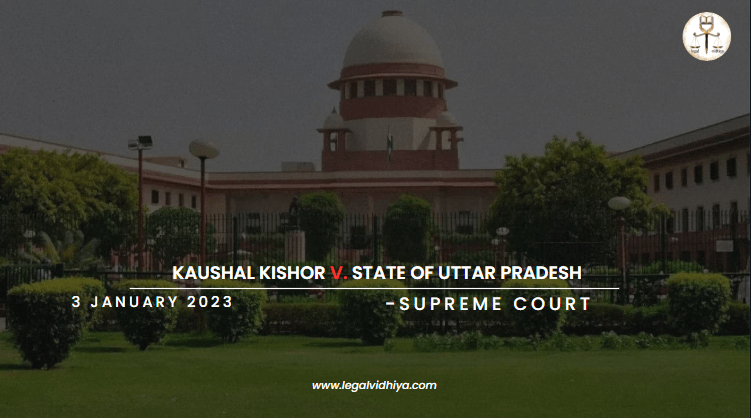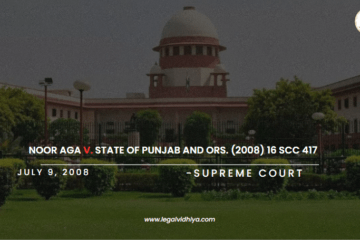
| CITATION | (2023) 4 SCC 1 |
| DATE OF JUDGMENT | 3 January 2023 |
| COURT | Supreme Court of India |
| APPELLANT | Kaushal Kishor |
| RESPONDENT | State of Uttar Pradesh and Ors. |
| BENCH | S Abdul Nazeer, AS Bopanna, BR Gavai, V Ramasubramanian & BV Nagarathna,JJ. |
INTRODUCTION
The Supreme Court of India ruled in this case that a public official’s right to free expression may not be curtailed in order to protect the basic rights of another person. The Court further declared that even in the face of non-state actors, the State has an obligation to defend people’s rights to life and personal liberty. This case resulted from two incidents in which Ministers made contentious statements disparaging crime victims. According to the victims, these statements infringed upon their Article 21 rights to life and personal freedom. The Court ruled that the only legitimate constraints on freedom of speech and expression are those listed in Article 19(2) of the Constitution, and that these grounds cannot be used as justification for additional restrictions. The Court also addressed the horizontal application of rights to state and non-state entities.
FACTS OF THE CASE
- The conflict began when Azam Khan, the State of Uttar Pradesh’s Minister for Urban Development at the time, made a remark in 2016 regarding some rape claims made by a survivor. The claims are a “political controversy only and nothing else,” according to the statement. The father of the survivor filed a petition with the Supreme Court in order to hold the Minister responsible for his remarks following the release of this statement.
- In this case, the court combined two complaints involving disparaging remarks made in two unrelated incidents by state ministers from Kerala and Uttar Pradesh. The case dealt with problems pertaining to the tension between the petitioners’ right to dignity and the ministers’ freedom of speech.
- A minister in the Uttar Pradesh (“UP”) government made disparaging remarks about two sex assault victims. He said that a “political controversy” against the administration stemmed from the sexual assault of a woman and her small child.
- In the second instance, a Kerala government minister made remarks that were deemed to be “highly derogatory to women.” Both petitions claimed that governmental employees had violated their constitutionally guaranteed right to dignity (Article 21).
- Both petitions were presented to the Supreme Court’s three-judge panel. Similar concerns were brought forth in both petitions, which also featured important legal problems about constitutional interpretation. Consequently, the issue was referred to the Court’s bench of five judges.
ISSUES RAISED
- Are the grounds listed in Article 19(2) for justifiable legal restrictions on the right to free speech exhaustive, or can other fundamental rights be used to impose restrictions on the right to free speech on grounds not listed in Article 19(2)?
- Is it possible to assert a basic right under Article 19 or 21 of the Indian Constitution in ways other than as a means of opposing the “State” or its agents?
- Is the State required under Article 21 of the Indian Constitution to actively defend an individual’s rights, even if such rights are threatened by the actions or inactions of a third party or a commercial organization?
- Given the concept of collective responsibility, may a ministerial statement that is linked to state matters or intended to shield the government be vicariously attributed to the government itself?
- Whether a Minister’s remarks that go against a citizen’s rights under Part Three of the Constitution are a violation of such rights and can be pursued as a “Constitutional Tort”.
CONTENTIONS OF APPEALENT
- Regarding Reasonable restrictions: Under Article 19(1)(a), ministers have the same rights to freedom of expression as other citizens. However, they are subject to the reasonable constraints outlined in Article 19(2), which are sufficient. “The court’s role is to protect fundamental rights limited by lawful restrictions, not to protect restrictions and grant residual privileges to the rights,” this is why.
- Regarding Collective Responsibilities: The majority opinion also distinguished between the government’s vicarious liability for the misguided or offensive statements made by any of its individual ministers.
- From the Council of Ministers to each individual minister, there is a stream of collective responsibility. The direction of flow is not from the Council of ministries to the individual ministries.
- The idea of “any and every statement orally made by a Minister outside the House of the People/Legislative Assembly” cannot be expanded to include “any and every statement.”
- Argument by an Individual Minister: The court also considered whether a minister’s remarks that go against people’ fundamental rights can be construed as constitutional torts. One legal mechanism that allows the state to be held vicariously liable for the acts of its agents is a constitutional tort.
- A minister’s speech that violates someone’s fundamental rights might not be actionable on its own, but it becomes actionable if the statement causes real harm or loss.
CONTENTIONS OF REPONDENT
- Concern over a Hateful Public conversation: “Hate speech, whatever its content, denies people dignity,” the minority ruling states, expressing concern about a hateful public conversation.
- It mentions the unique responsibility placed on public officials and other powerful individuals to “understand and measure their words,” to speak more responsibly and in moderation.
- Regarding Collective Responsibility: If a minister’s opinion is relevant to state matters and expresses the government’s position, then the government may be held vicarious responsible.
- Should a statement of that like be at odds with the Government’s position, it can be directly attributed to the Minister.
- Statement from a Particular Minister: It is of the opinion that actions and inactions that qualify as “constitutional torts” ought to be defined by a suitable legal framework.
JUDGEMENT
The bench ruled that Article 19(2) for exercising freedom of speech and expression is an exhaustive list, and no additional restrictions can be placed even if two fundamental rights are competing. Article 19 and 21 are enforceable against non-state entities, but Justice B.V. Nagarathna disagreed, stating that a sufficient remedy to file a habeas corpus writ petition is already provided. Thus, Articles 19 and 21 are not enforceable against non-state entities that do not fall under the definition of Article 12. The bench placed an affirmative duty on the state to protect citizens’ life and liberty from private entities, but Article 21 places a negative duty on the state to not deprive any person of life and personal liberty except by the law. Justice Nagarathna argued that interference by the state to protect Article 21 from private actors would infringe on the negative duty. On the principle of collective responsibility, the majority bench decided that a statement made by a minister related to state affairs cannot make the government vicariously liable for it. Justice Nagarathna disagreed, arguing that a statement made by a minister related to the government’s affairs makes the state vicariously liable, and if the statement is inconsistent with the government’s view, there is no vicarious liability on the state.
ANALYSIS
In 2016, a 13-year-old girl and her mother were allegedly gang-raped on National Highway 91 in Uttar Pradesh. Uttar Pradesh Minister and Samajwadi Party leader Azam Khan accused the incident of a political conspiracy. The victims filed a writ petition against the minister, requesting a transfer of the case to another state. The Supreme Court, with the assistance of Amicus Curiae, ordered a stay on the investigation and ordered an unconditional apology from Azam Khan. The core issue was whether the right to freedom of speech and expression under Article 19(1)(a) is restricted by only Article 19(2) or by other fundamental rights, specifically Article 21. The case was referred to a five-judge constitution bench in April 2017, and the Amicus Curiae was asked to formulate questions of law for consideration. The questions were framed and submitted to the Court on July 31, 2017. On October 23, 2019, a Constitution Bench began hearing the matter, hearing the case. The court emphasized the need for new tools to enhance justice and ensure public confidence in the fairness of trials.
CONCLUSION
Kaushal Kishor serves as a valuable example of judicial moderation in handling abstract philosophy rather than a tangible case. One of the trickiest and most multifaceted topics in modern constitutionalism is horizontality, which involves a plethora of related questions regarding the structure of the State, institutional power imbalances, public and private law, remedies, and so forth. Only when a rights-bearer and a rights-violator are in front of the court, and the question of whether horizontal rights apply, can these concerns be addressed in the real world. As we’ve seen, in its absence, confusion results, and even worse, the formerly (relatively) clear waters become murky. As with Kaushal Kishor, all that can be hoped for is that, in the course of time, the judgment becomes judicial desuetude and that, upon reviewing the majority, future courts will deem it to be merely impossible of application.
REFERENCES
- SCC Online
- https://indiankanoon.org/doc/103640961/
- https://www.scobserver.in/cases/kaushal-kishor-uttar-pradesh-azam-khan-freedom-of-speech-and-expression-case-background/amp/
This Article is written by Ashi Sangwan student of Guru Gobind Singh Indraprastha University, Delhi (FIMT); Intern at Legal Vidhiya.
Disclaimer: The materials provided herein are intended solely for informational purposes. Accessing or using the site or the materials does not establish an attorney-client relationship. The information presented on this site is not to be construed as legal or professional advice, and it should not be relied upon for such purposes or used as a substitute for advice from a licensed attorney in your state. Additionally, the viewpoint presented by the author is of a personal nature.




0 Comments